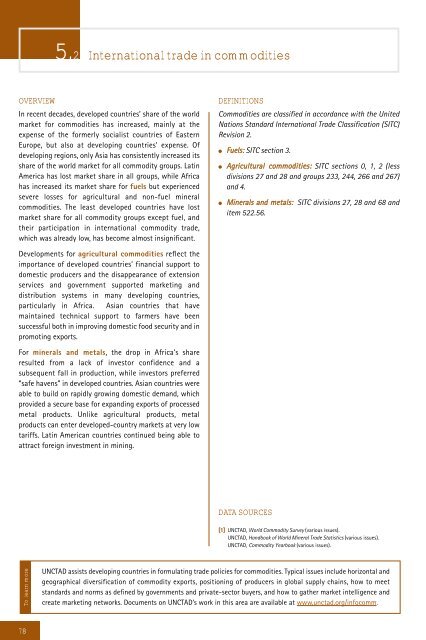Development and Globalization: - Unctad
Development and Globalization: - Unctad
Development and Globalization: - Unctad
Create successful ePaper yourself
Turn your PDF publications into a flip-book with our unique Google optimized e-Paper software.
OVERVIEW DEFINITIONS<br />
In recent decades, developed countries’ share of the world<br />
market for commodities has increased, mainly at the<br />
expense of the formerly socialist countries of Eastern<br />
Europe, but also at developing countries’ expense. Of<br />
developing regions, only Asia has consistently increased its<br />
share of the world market for all commodity groups. Latin<br />
America has lost market share in all groups, while Africa<br />
has increased its market share for fuels but experienced<br />
severe losses for agricultural <strong>and</strong> non-fuel mineral<br />
commodities. The least developed countries have lost<br />
market share for all commodity groups except fuel, <strong>and</strong><br />
their participation in international commodity trade,<br />
which was already low, has become almost insignificant.<br />
<strong>Development</strong>s for agricultural commodities reflect the<br />
importance of developed countries’ financial support to<br />
domestic producers <strong>and</strong> the disappearance of extension<br />
services <strong>and</strong> government supported marketing <strong>and</strong><br />
distribution systems in many developing countries,<br />
particularly in Africa. Asian countries that have<br />
maintained technical support to farmers have been<br />
successful both in improving domestic food security <strong>and</strong> in<br />
promoting exports.<br />
For minerals <strong>and</strong> metals, the drop in Africa’s share<br />
resulted from a lack of investor confidence <strong>and</strong> a<br />
subsequent fall in production, while investors preferred<br />
“safe havens” in developed countries. Asian countries were<br />
able to build on rapidly growing domestic dem<strong>and</strong>, which<br />
provided a secure base for exp<strong>and</strong>ing exports of processed<br />
metal products. Unlike agricultural products, metal<br />
products can enter developed-country markets at very low<br />
tariffs. Latin American countries continued being able to<br />
attract foreign investment in mining.<br />
To learn more<br />
78<br />
5.2 International trade in commodities<br />
Commodities are classified in accordance with the United<br />
Nations St<strong>and</strong>ard International Trade Classification (SITC)<br />
Revision 2.<br />
● FFuueellss:: SITC section 3.<br />
● AAggrriiccuullttuurraall ccoommmmooddiittiieess:: SITC sections 0, 1, 2 (less<br />
divisions 27 <strong>and</strong> 28 <strong>and</strong> groups 233, 244, 266 <strong>and</strong> 267)<br />
<strong>and</strong> 4.<br />
● MMiinneerraallss aanndd mmeettaallss:: SITC divisions 27, 28 <strong>and</strong> 68 <strong>and</strong><br />
item 522.56.<br />
DATA SOURCES<br />
[1] UNCTAD, World Commodity Survey (various issues).<br />
UNCTAD, H<strong>and</strong>book of World Mineral Trade Statistics (various issues).<br />
UNCTAD, Commodity Yearbook (various issues).No. 159.<br />
UNCTAD assists developing countries in formulating trade policies for commodities. Typical issues include horizontal <strong>and</strong><br />
geographical diversification of commodity exports, positioning of producers in global supply chains, how to meet<br />
st<strong>and</strong>ards <strong>and</strong> norms as defined by governments <strong>and</strong> private-sector buyers, <strong>and</strong> how to gather market intelligence <strong>and</strong><br />
create marketing networks. Documents on UNCTAD’s work in this area are available at www.unctad.org/infocomm.

















